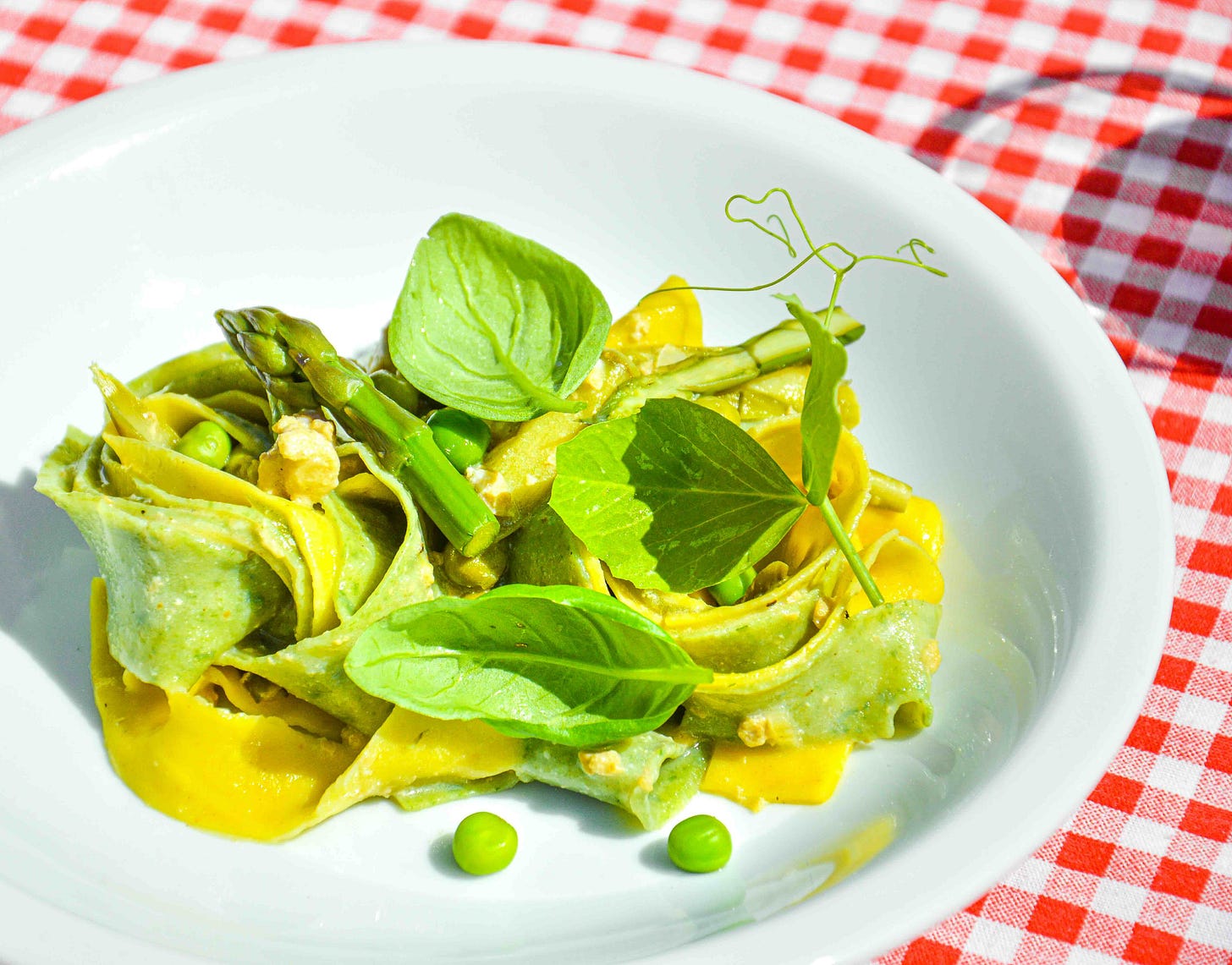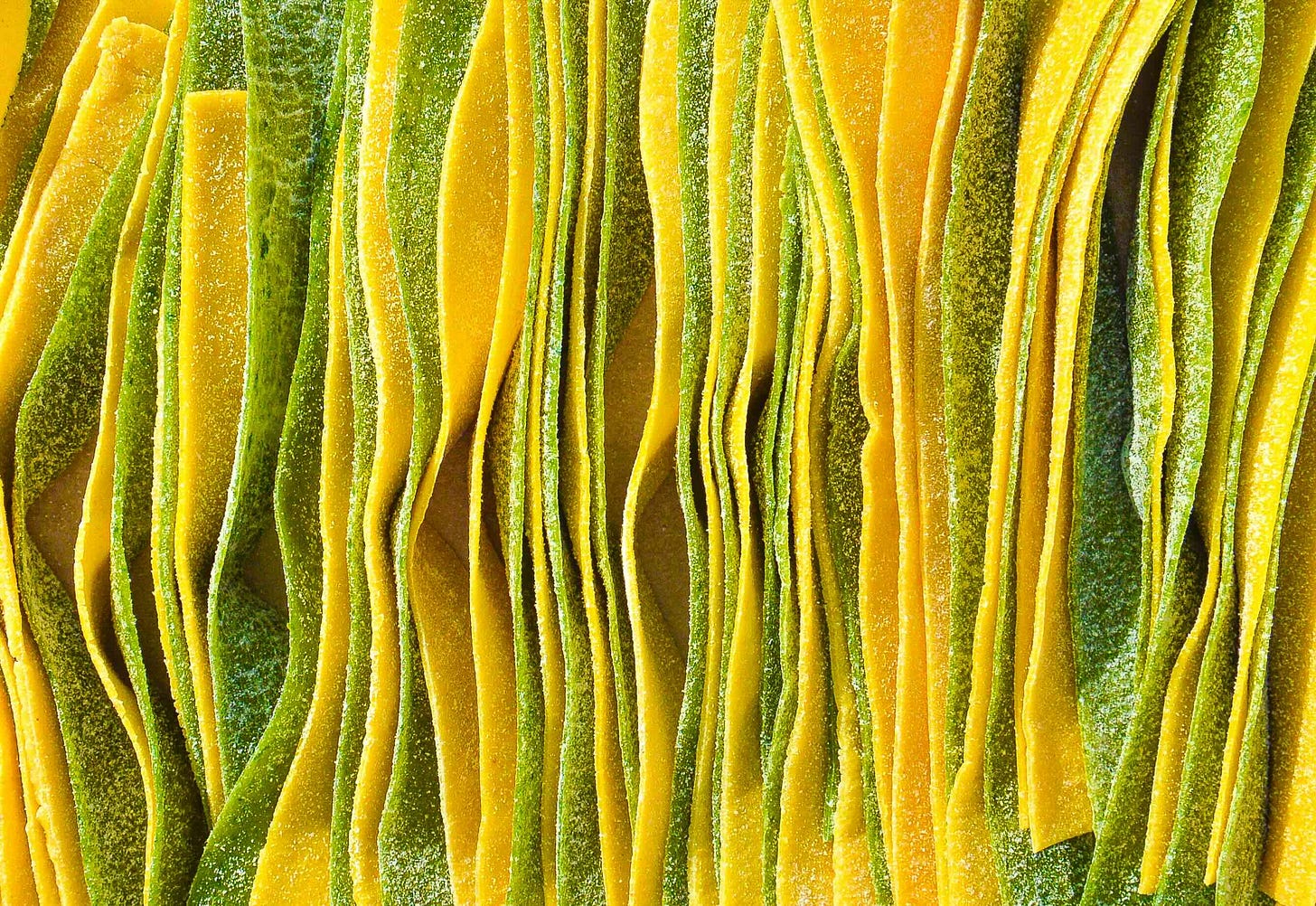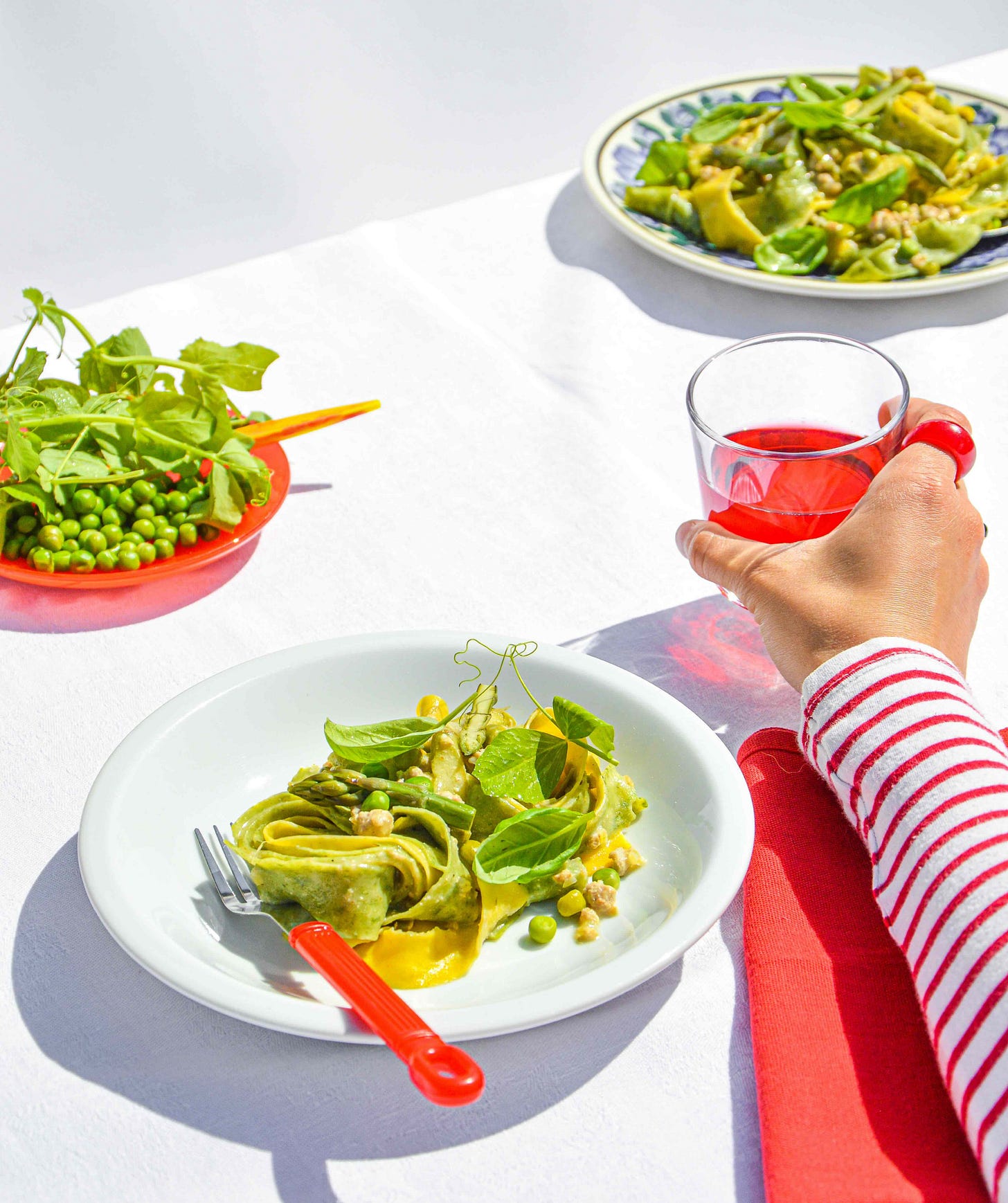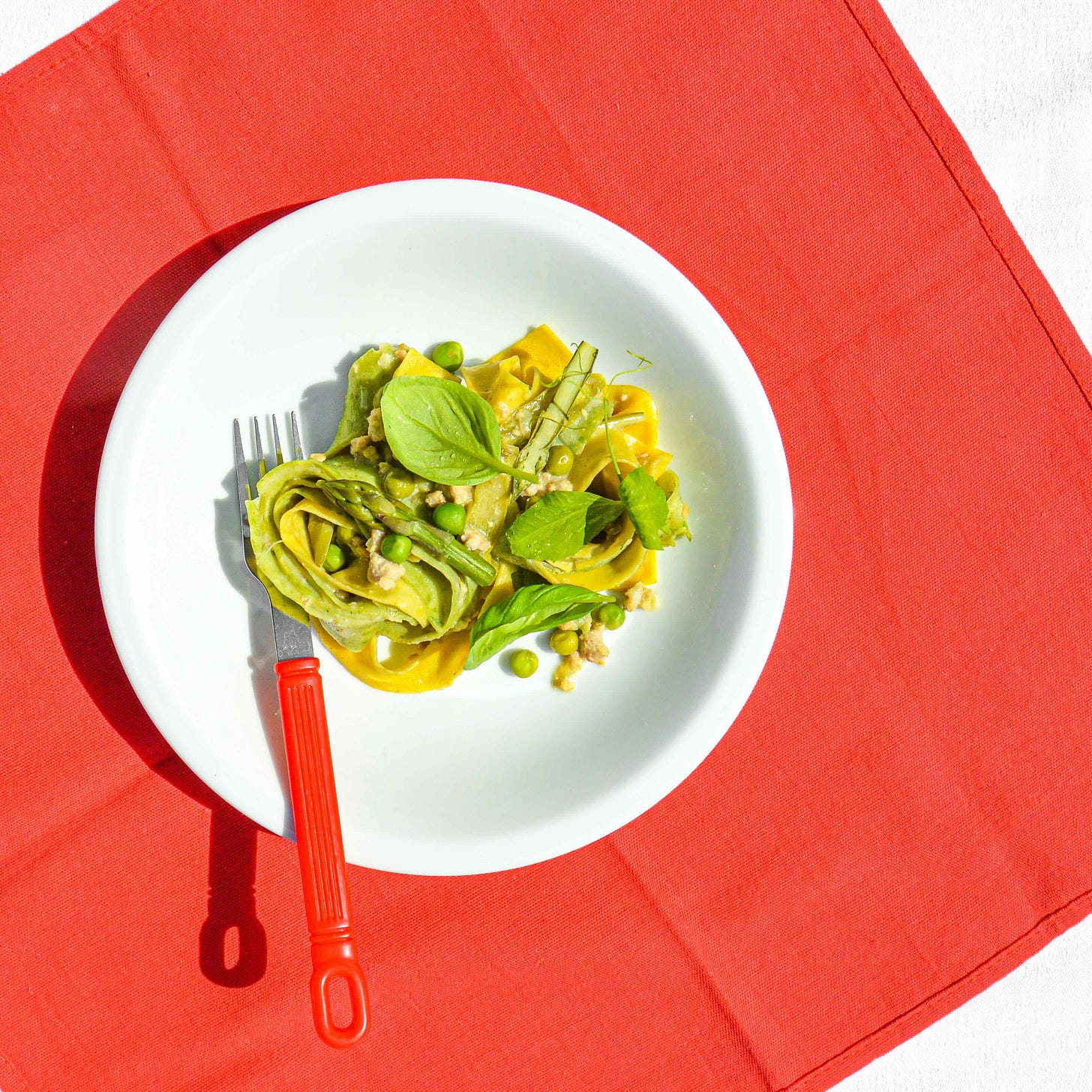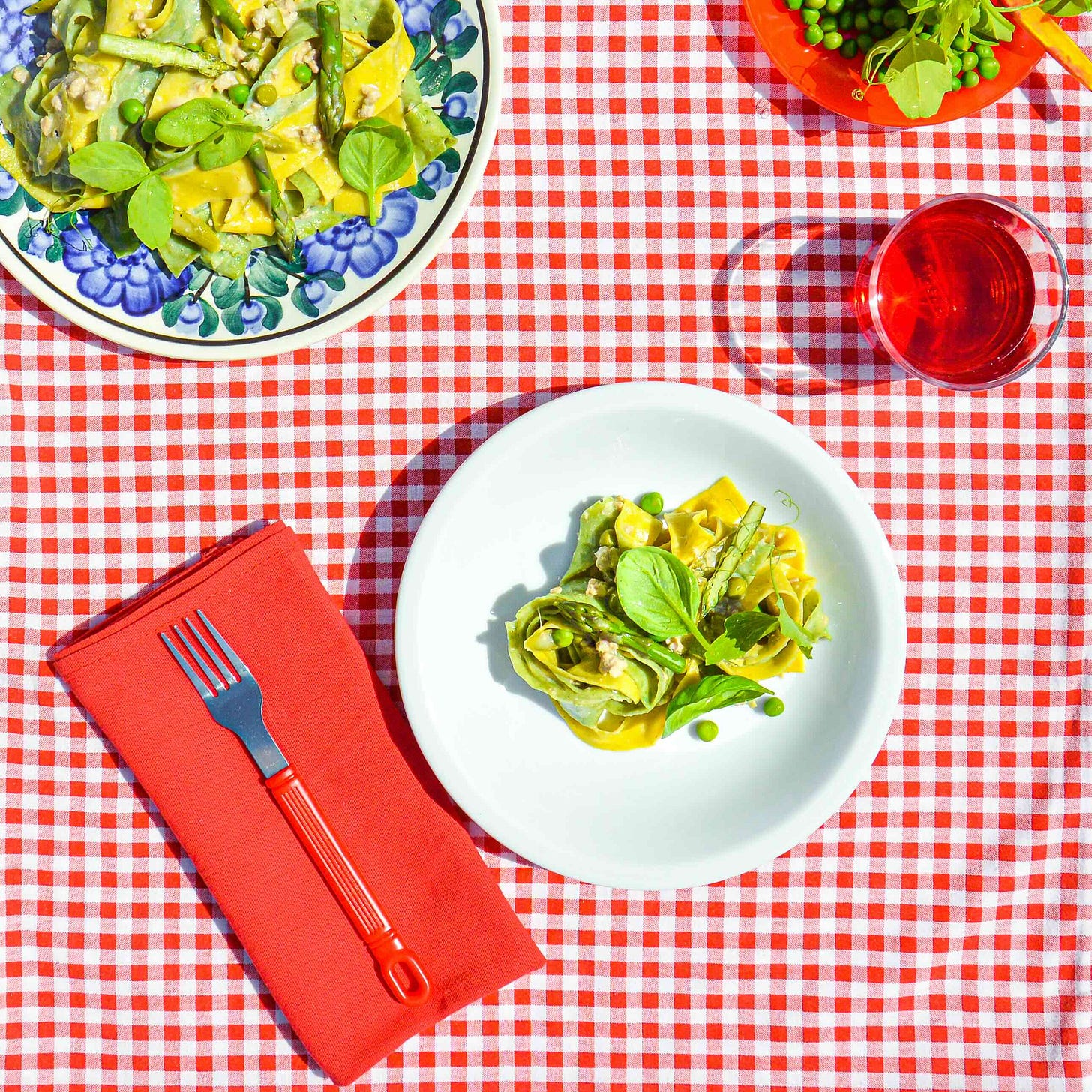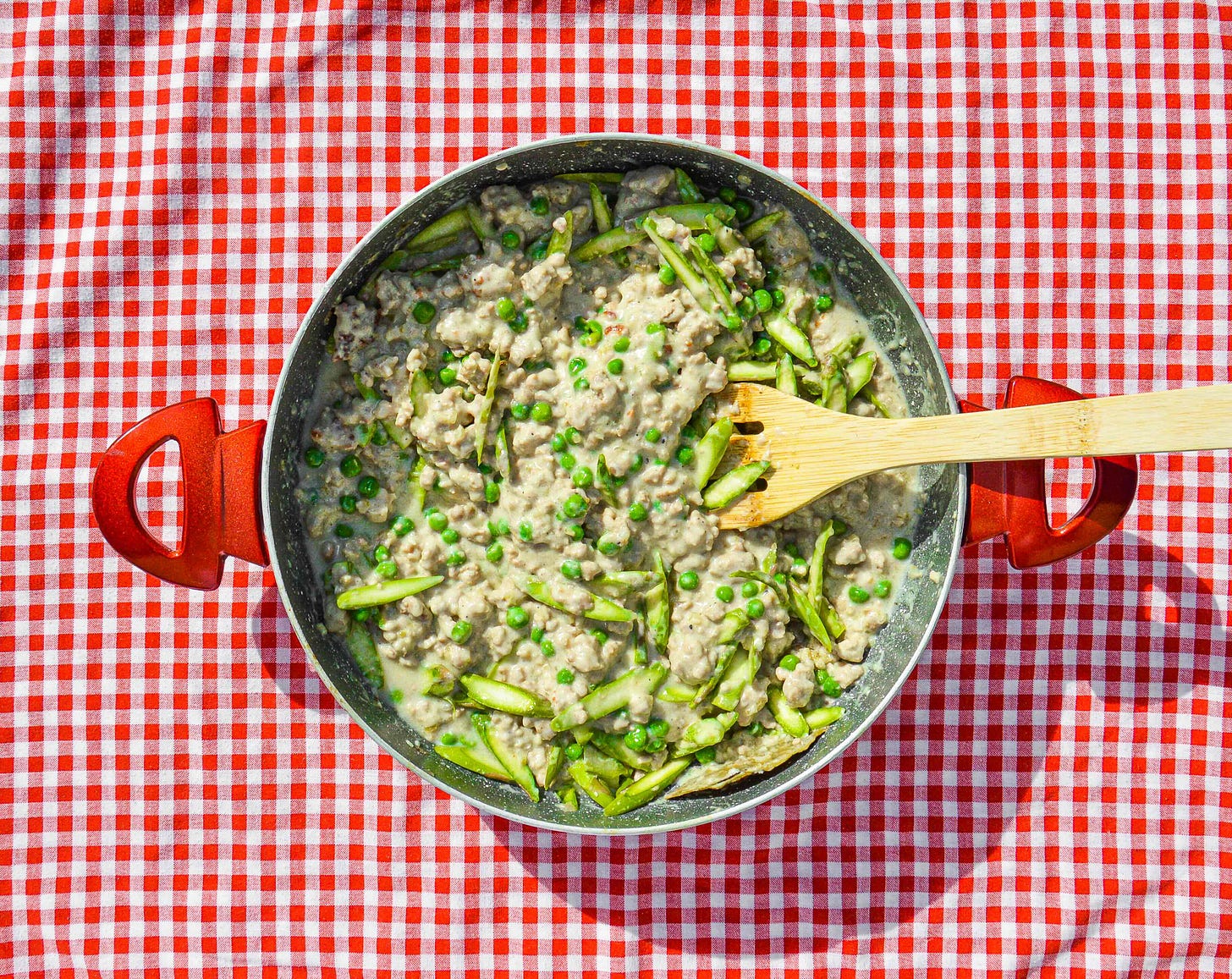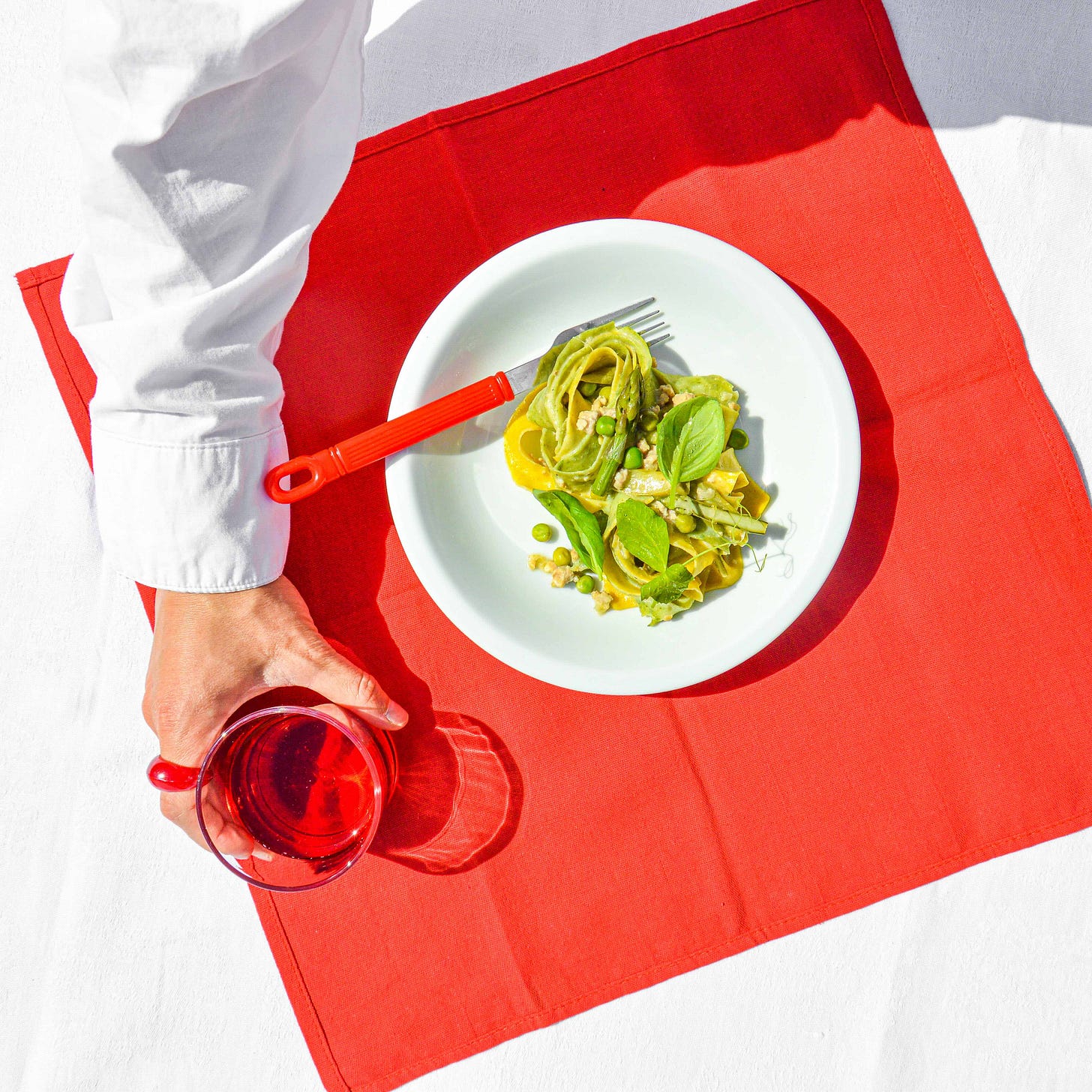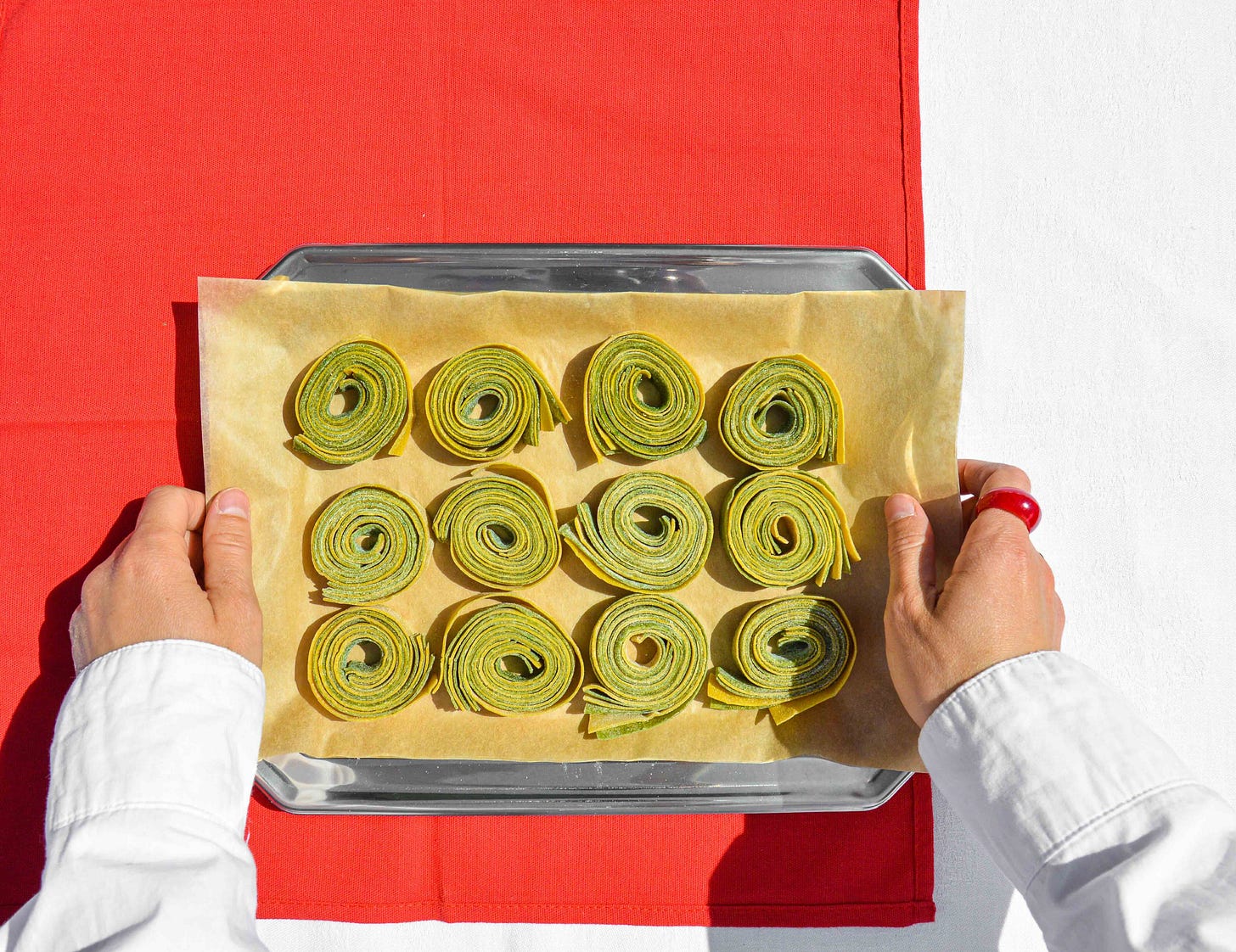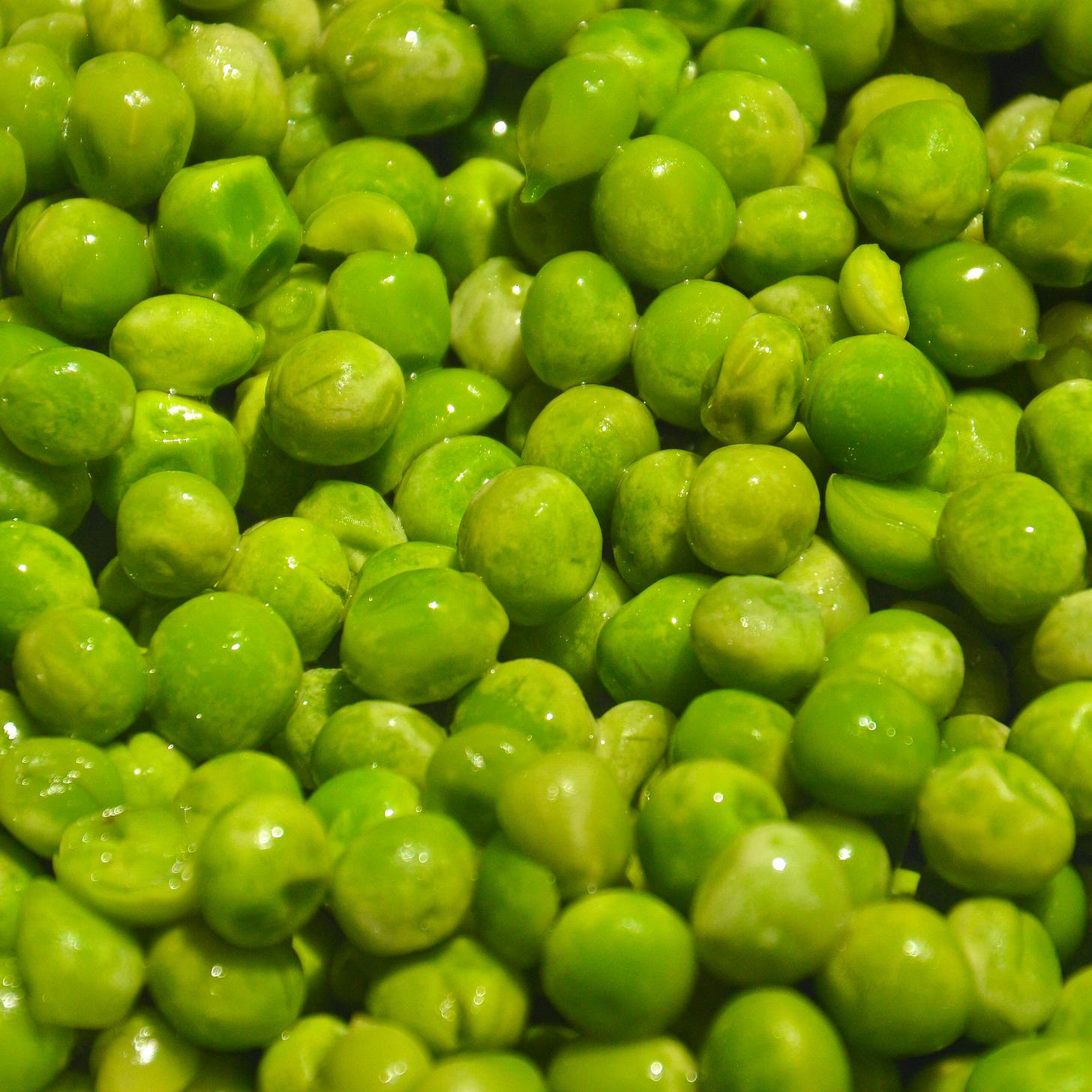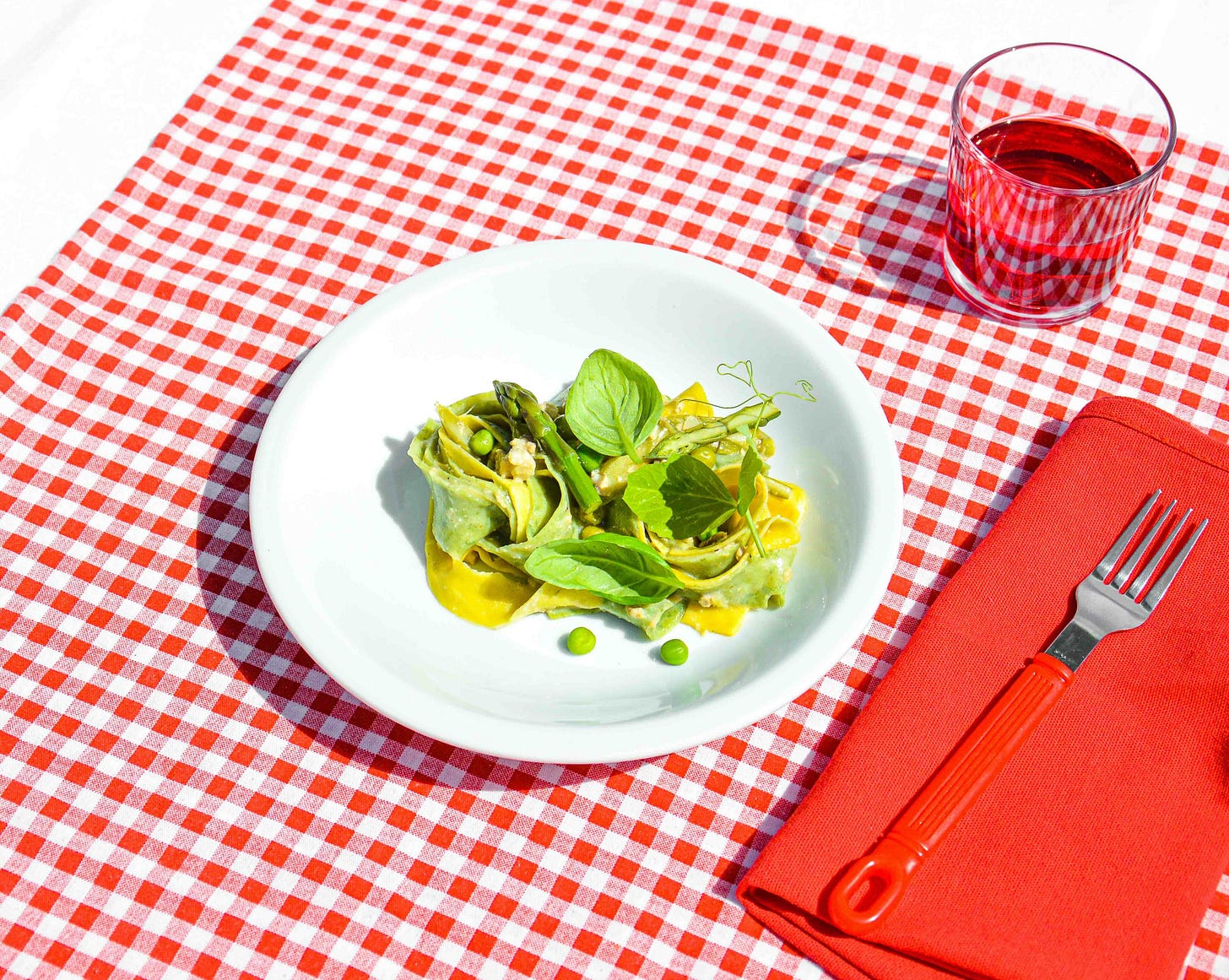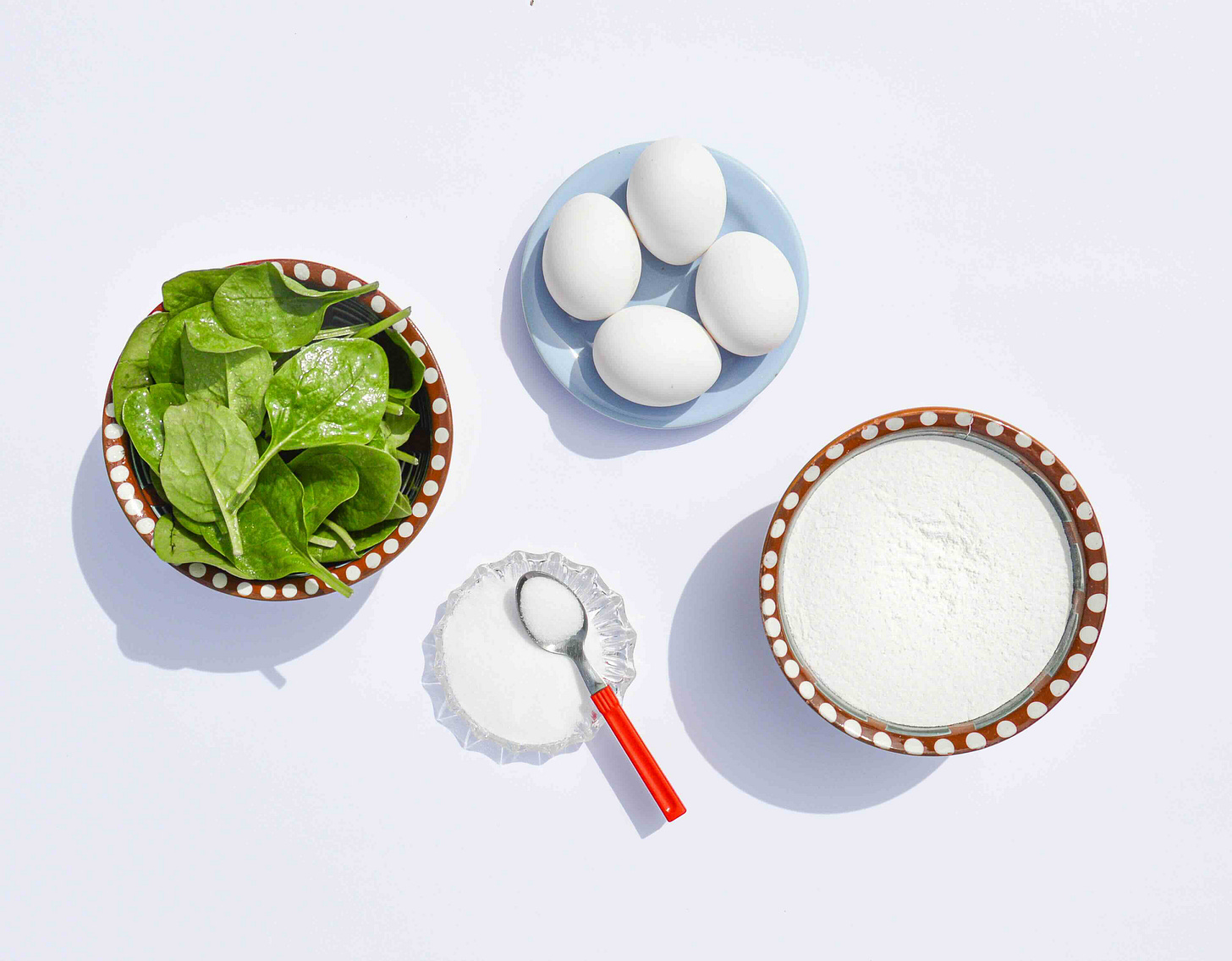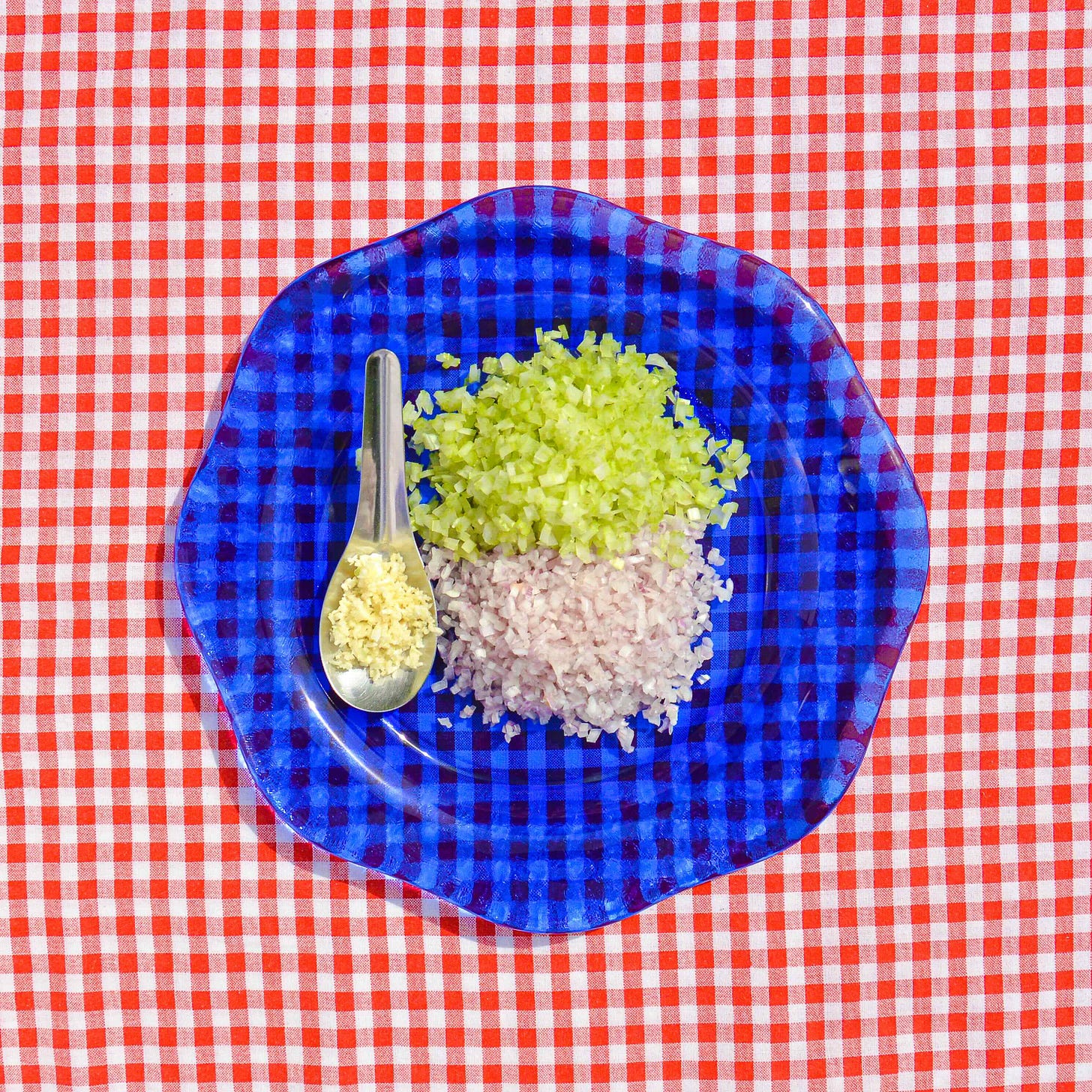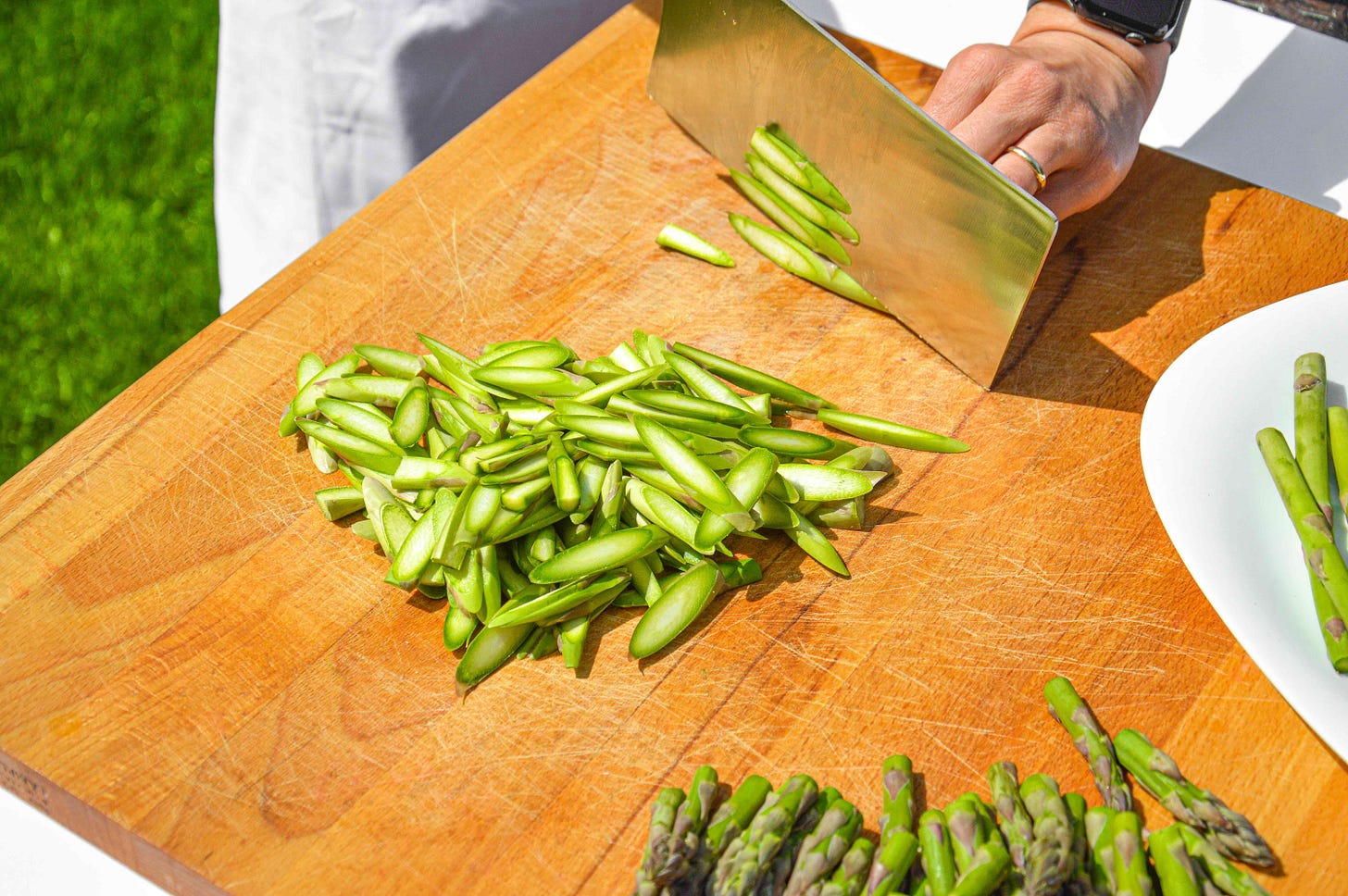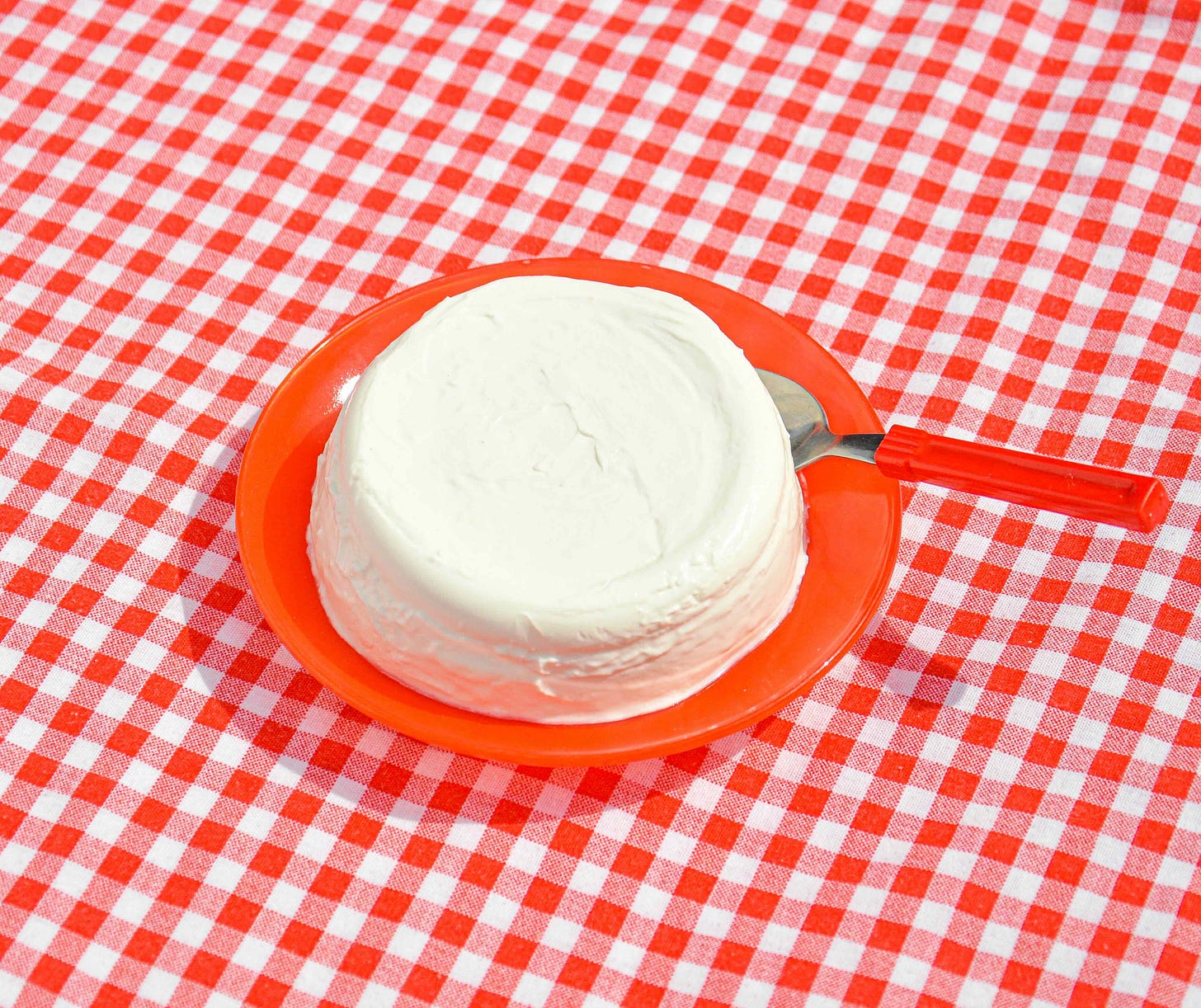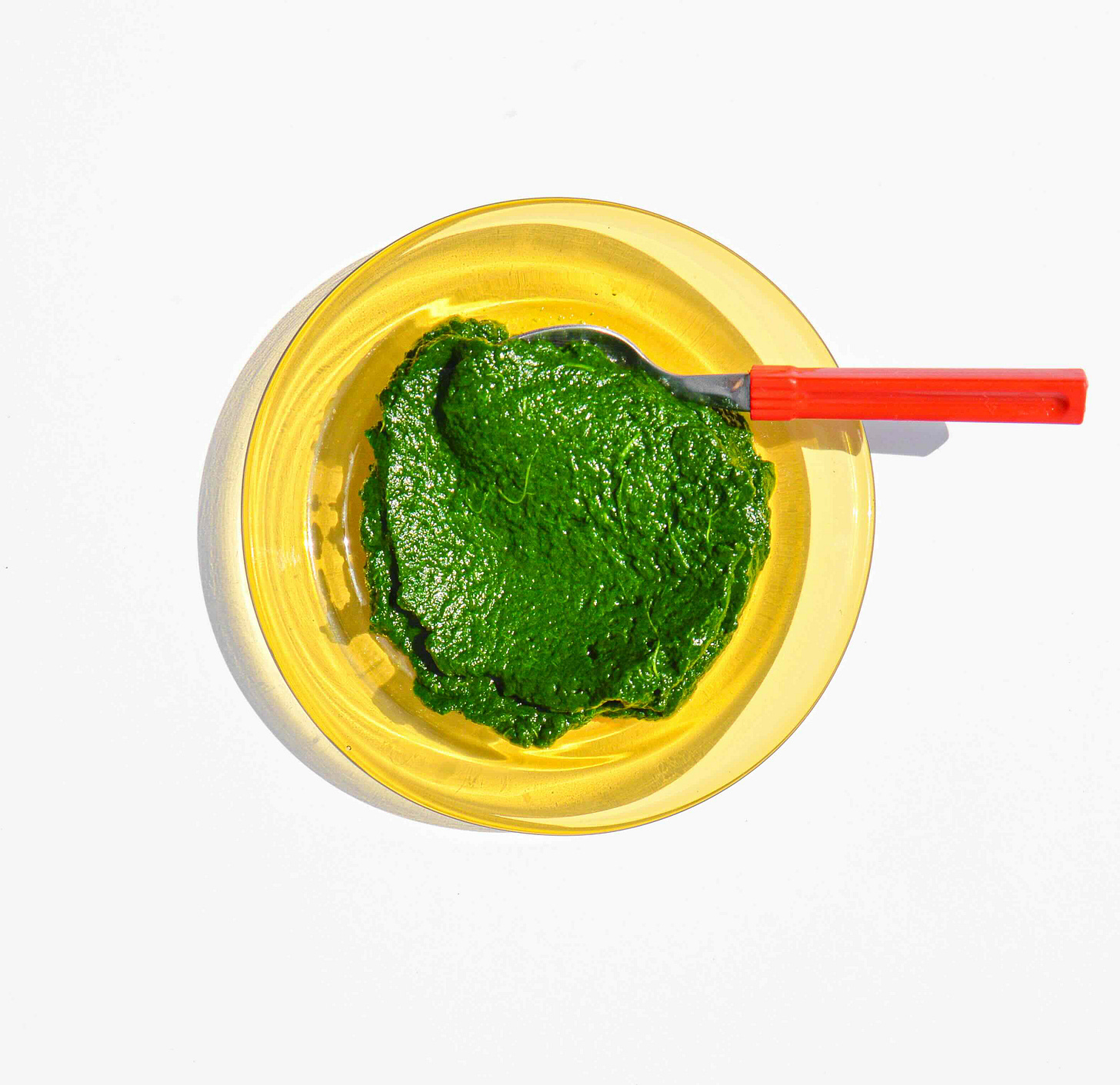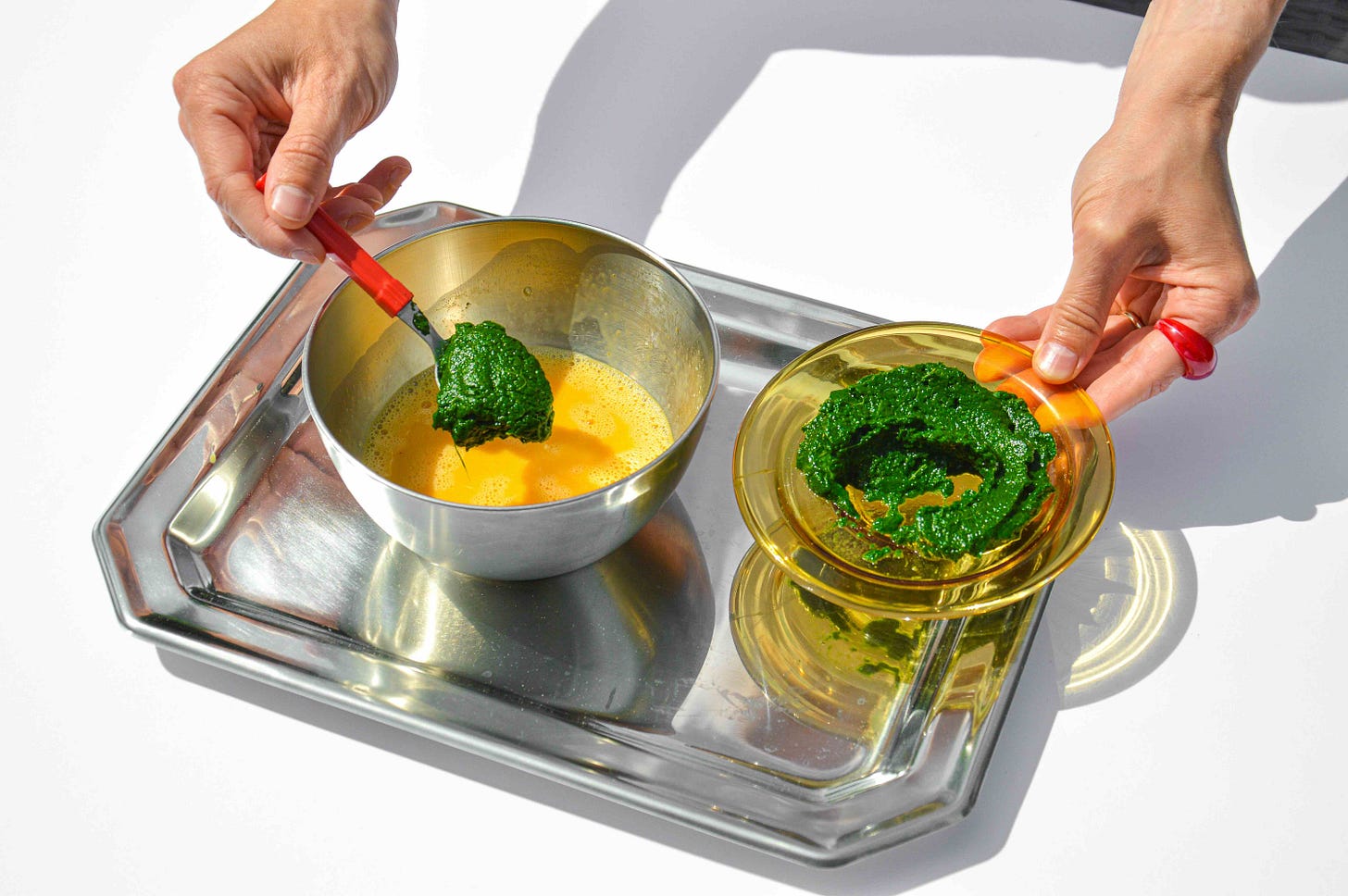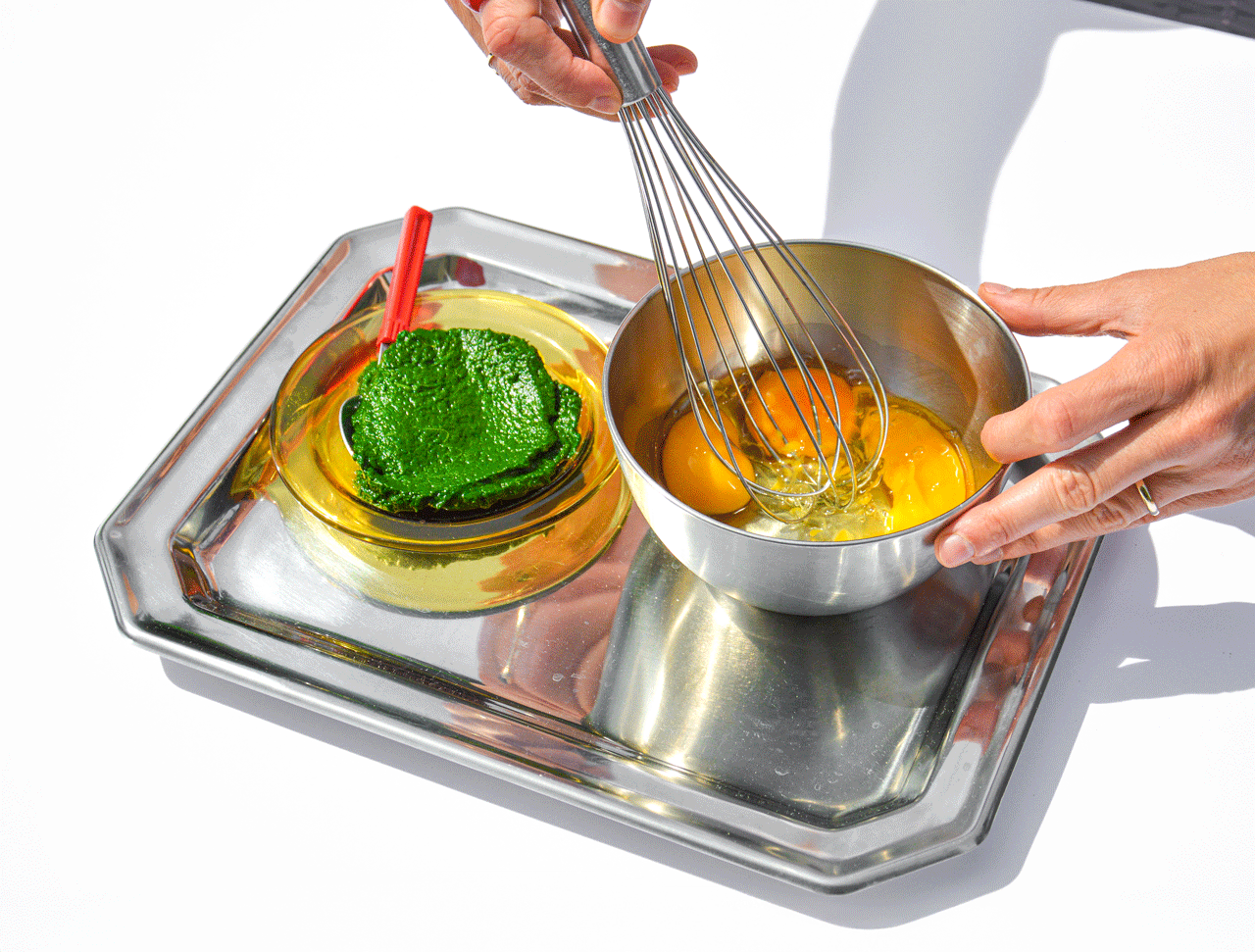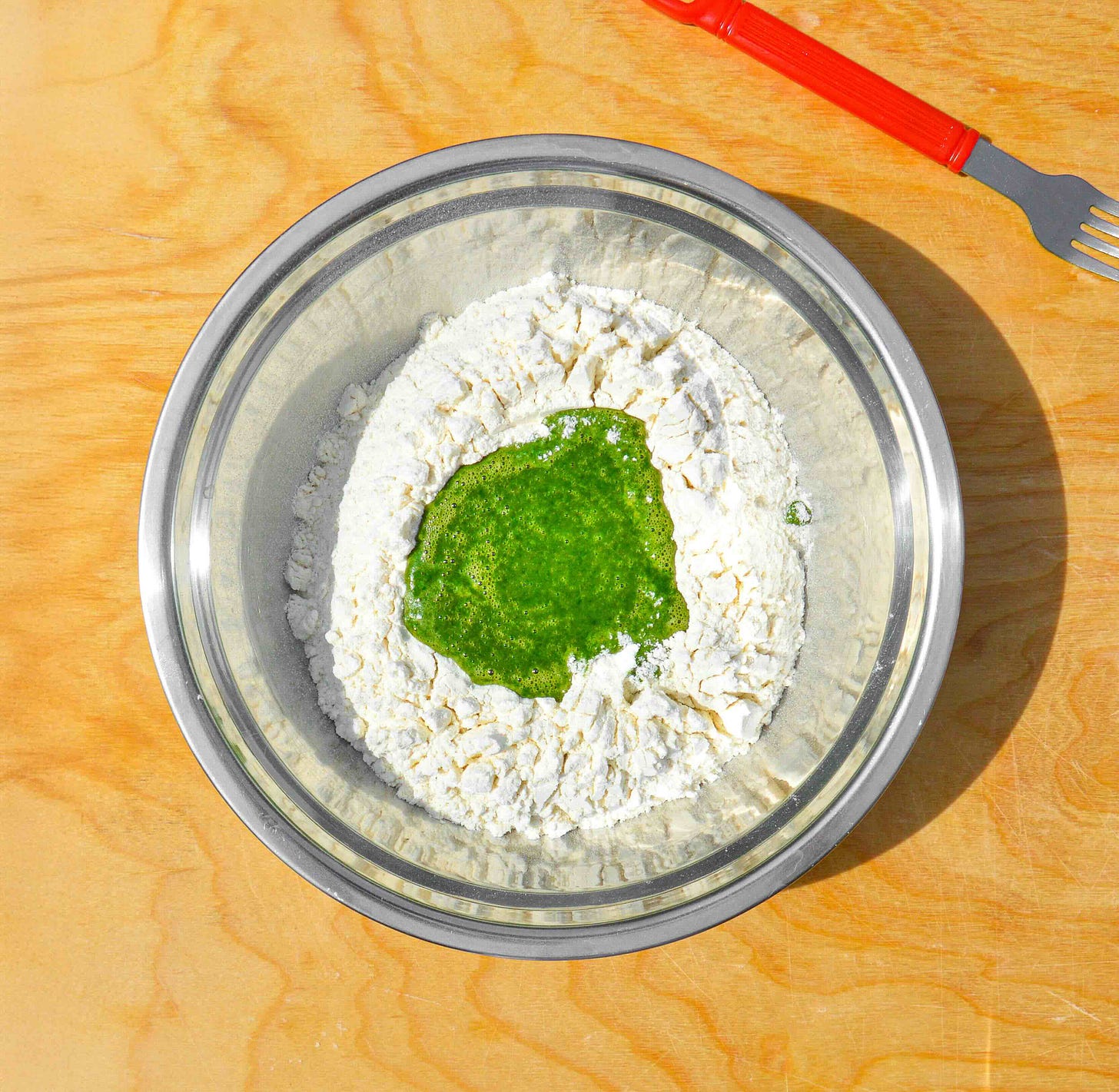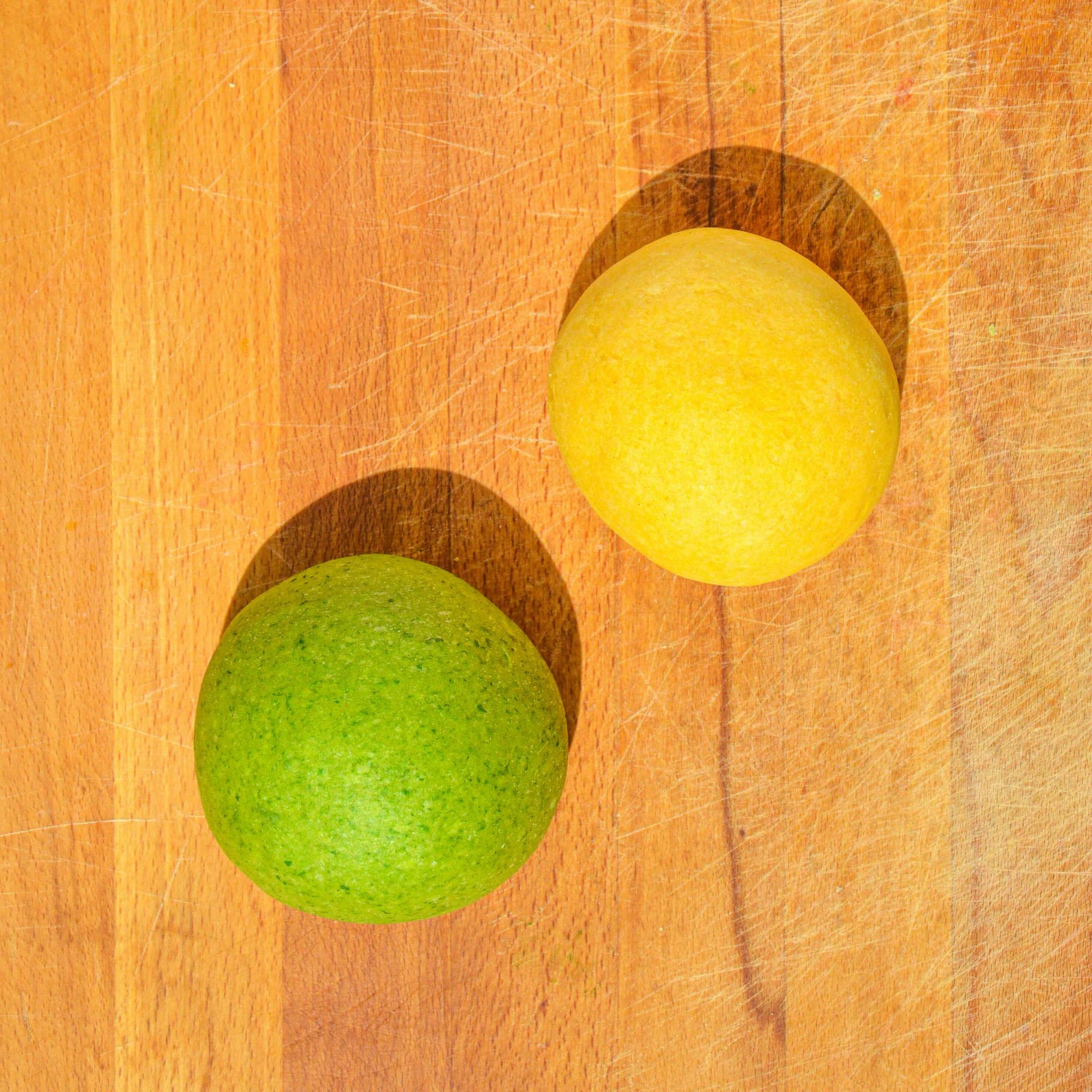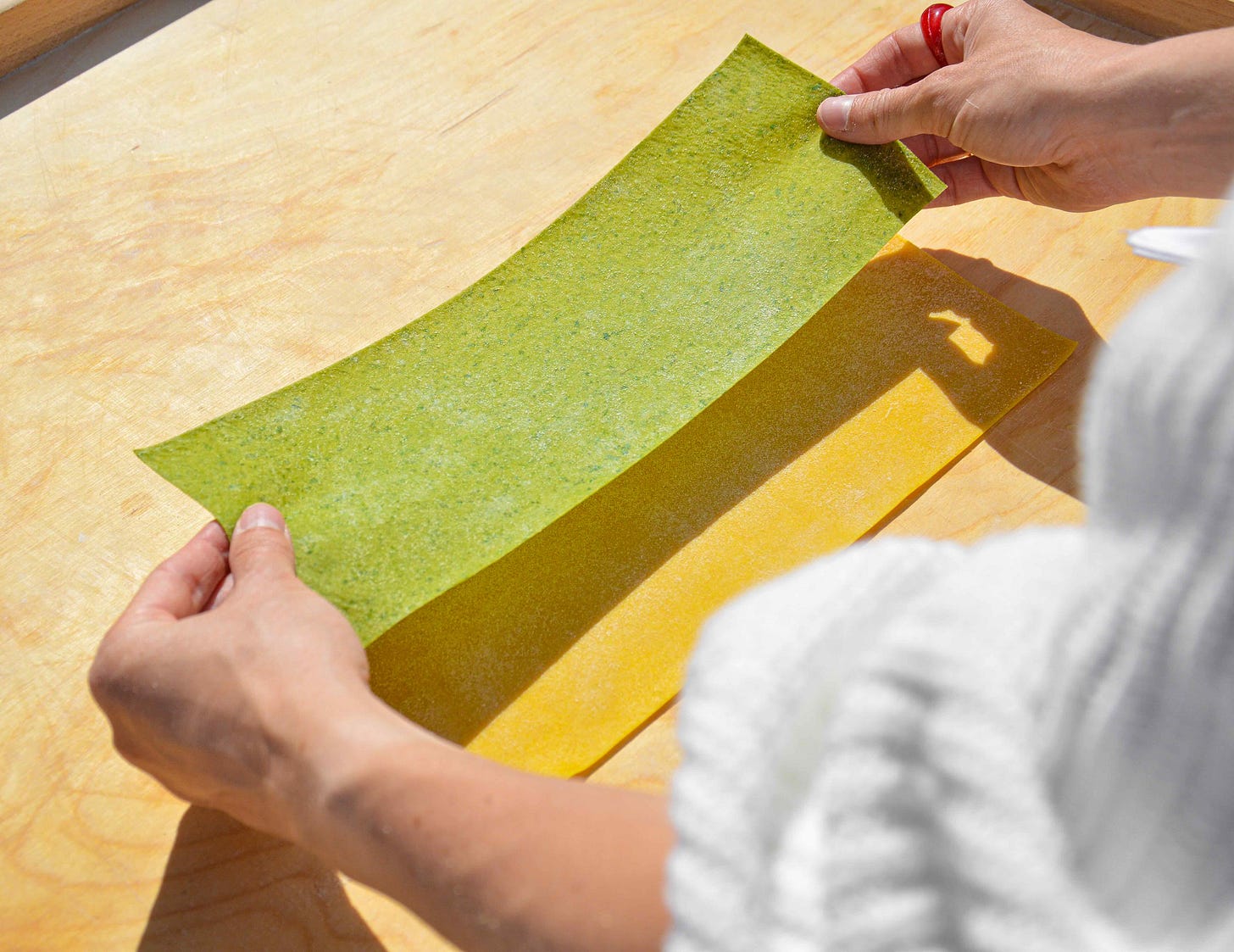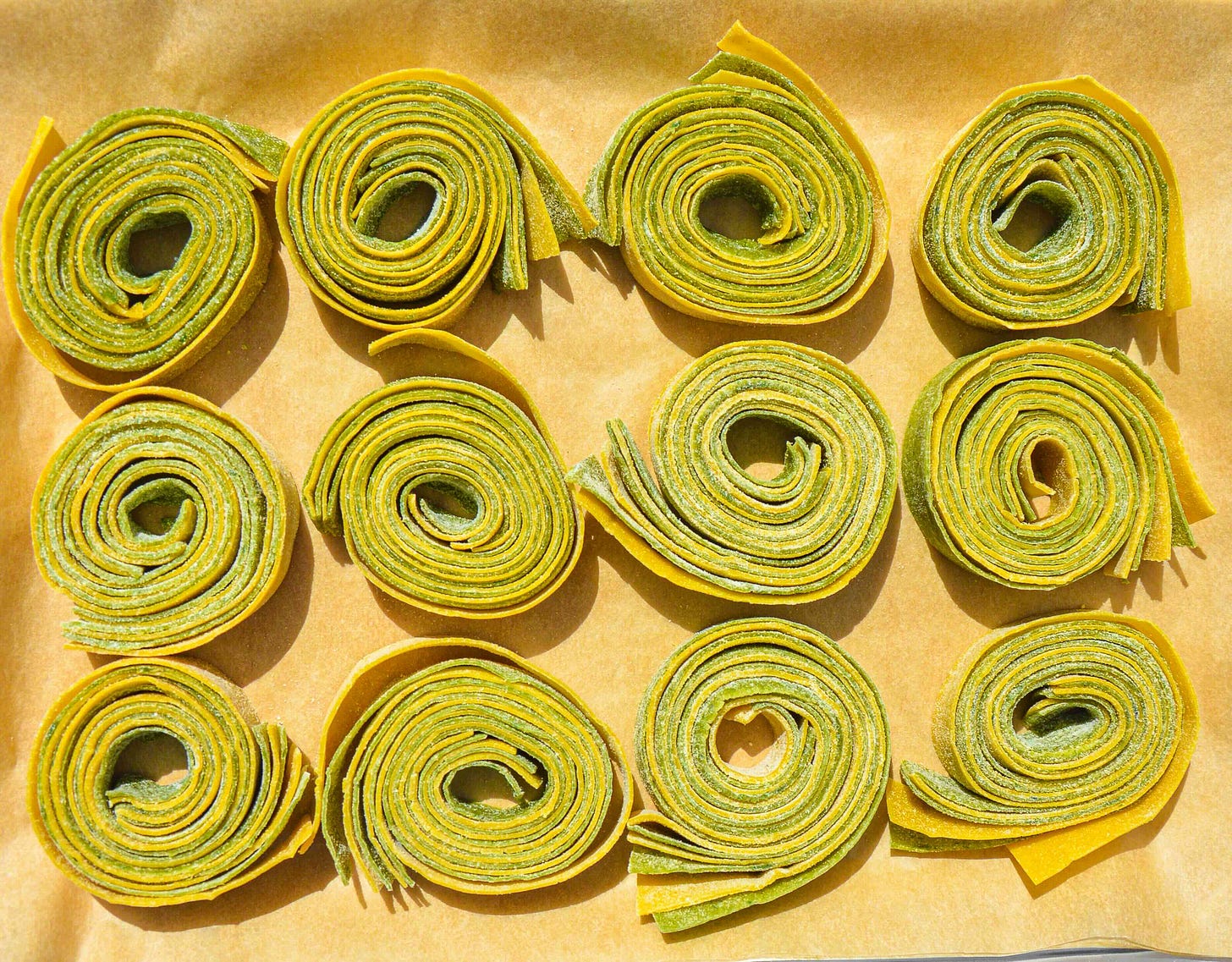Paglia e fieno
Serve: ~8 portions
Ingredients
Green pasta
400g 00 flour + some for dusting
4 whole eggs
2 egg yolks
200g fresh spinach
sea salt
Yellow pasta
400g 00 flour + some for dusting
4 whole eggs
4 egg yolks
sea salt
White ragù
450g minced pork
50g unsalted butter
1 shallot
2 celery sticks
2 garlic cloves
50g white wine
600g chicken stock
3 bay leaves
150g mascarpone
100g peas
500g asparagus
fresh basil
sea salt
black peppercorn
Extra note
Paglia e fieno is a two-coloured tagliatelle that originates from Tuscany (particularly popular in Siena) and Emilia-Romagna. Traditionally, it’s served with a cream-based sauce featuring prosciutto and peas
In this version, I’ve taken a slightly different approach. I opted for pappardelle instead of tagliatelle, and rather than using prosciutto, I created a white ragù made with mascarpone and added green asparagus
To make this dish more manageable, you can split the preparation over two days. On the first day, prepare the white ragù and blend the spinach for the pasta dough. On the second day, make the fresh pasta!
I used a pasta machine to roll out the dough, but if you don’t have one, you can easily do it by hand
Method
DAY 1
White ragù
Brunoise 1 shallot and 2 celery stalks, and mince 2 garlic cloves.
Trim about 2.5 cm off the woody ends of the asparagus spears.
Bring a small pot of water to a boil.
Cut the asparagus tips and slice them in half. I reserved the tips for garnish, but you can mix them with the rest of the asparagus if you prefer. If you're keeping them separate, blanch the tips for about 2 minutes, then drain and refresh them in cold water, and set them aside.
Slice the remaining asparagus diagonally, as shown below.
Heat a generous amount of olive oil in a pan. Add the shallot and celery, and sauté over low to medium heat until soft. Add the minced garlic and cook for a few more minutes, being careful not to let it burn.
Once the shallot, celery, and garlic are cooked, deglaze the pan with a splash of white wine, scraping up any bits with a spatula. Transfer everything to a small bowl and set aside.
Add some olive oil to the same pan (no need to wash it). Once hot, add the pork. Break up any larger chunks with a wooden spoon, season with salt and black pepper, and cook for about 10 minutes, or until fully cooked through.
Return the cooked shallot, celery, and garlic to the pan along with the bay leaves. Pour in the chicken stock, stir everything together, and let it simmer gently for about an hour. Check every 15 minutes to make sure there’s enough liquid and that nothing is sticking to the bottom of the pan.
After an hour of cooking, add the mascarpone and stir to combine. Simmer for another 10 minutes over low heat.
Add the sliced asparagus and cook for about 5 minutes, or until tender. Three minutes after adding the asparagus, stir in the peas and cook for another 3 minutes. If the sauce is too thick, add a splash of water to loosen it up.
Taste the ragù and season with salt and black pepper.
Spinach
Bring a medium pot of water to a boil and season with salt. Once boiling, blanch the spinach for 1 minute. Drain it and rinse it under cold water to preserve its colour.
Remove the excess water and blend the spinach until it forms a smooth, paste-like consistency. Since there's not a lot of spinach, I recommend placing it in a tall, narrow container and using a hand blender.
DAY 2
Green pasta
Whisk 4 whole eggs and 2 egg yolks together in a bowl, then stir in the blended spinach.
Whisk everything until well combined.
Sift the flour into a bowl, add a pinch of salt, and mix. Create a well in the centre (large enough to hold the egg and spinach mixture), then pour in the eggs and spinach.
Using a fork, gently stir in the flour, gradually incorporating it into the egg mixture. Continue until the eggs and flour are mostly combined.
Once the mixture starts to come together and is too thick to mix with a fork, transfer it to the counter.
Begin bringing the dough together with your hands. At first, it may look shaggy and sticky, but be patient, and it will start to come together.
Knead the dough by pressing the heel of your palm in the middle of the dough, stretching it away from your body. Fold the dough over, press it down, and rotate it. Repeat this process until the dough becomes more pliable and noticeably smoother.
Flatten the dough, place it in a plastic bag, and let it rest for about 30 minutes at room temperature.
After the resting time, give the dough a few more kneads. It should look something like this:
Divide the dough into 4 equal pieces. Place 3 of the pieces in a plastic bag to keep them from drying out.
Take one portion of the dough and press it with your hands to flatten it into a rough square shape so that it can easily be passed through the pasta machine.
Start with the widest setting (I began with number 1) and run the dough through the machine twice. If the dough becomes sticky, lightly dust both sides with flour. Next, adjust the machine to setting number 3 and roll the dough through again.
Lay the thinned dough horizontally, then fold the right side toward the middle and the left side over the top as presented below.
Roll out the dough diagonally with a rolling pin.
Set the pasta machine to setting number 4 and feed the dough through. Fold it again by bringing the right side to the middle and the left side over the top, then roll it out with a rolling pin.
Next, roll the dough through setting number 5, then through setting number 6 twice. If the dough becomes too long and hard to manage, you can cut it in half. Make sure the pappardelle needs to remain fairly long and that all the pasta sheets are cut to a consistent size.
Once you've rolled out a quarter of the green pasta dough, lightly dust both sides of the sheets with flour and lay them on a piece of cling film, making sure they don’t overlap. Cover with another layer of cling film and a kitchen towel to keep them from drying out.
Repeat the whole process of rolling out the sheets with the remaining dough, keeping an eye on the prepared sheets as you go to ensure they stay soft.
Yellow pasta
Follow the same process as for the green pasta, with one key difference: this time, you'll add 2 more egg yolks since there’s no spinach in this batch.
Assembling the two-coloured pasta
Once you've prepared all the yellow and green sheets, match up similar lengths of both colours and stack two sheets on top of each other. Trim the edges, but don’t discard them - you can reuse these scraps by adding them to a soup next time!
Cover the stack with cling film and a kitchen towel to keep it from drying out.
Continue with the remaining sheets, making sure to keep them covered as you go.
Roll up all the sheets into a cylinder and cover them again.
Take a large, sharp knife and cut the pappardelle into wide strips about 2 cm wide.
Unfold the pasta and lay it out on the counter. If it feels sticky, lightly dust it with a bit of flour.
Take 3 yellow and 3 green strands, laying them on top of each other, alternating the colours. Then, roll them up as shown below.
Serving
Bring a pot of water to a boil, and add a generous pinch of salt. Drop in pappardelle carefully and cook for about 3 minutes or until al dente.
Meanwhile, warm the white ragù over medium heat, stirring in a splash of water if needed to thin it out.
Once the pappardelle is cooked, drain it and run it under cold water to stop the cooking process. Add the pasta to the sauce and toss to combine. Serve with fresh basil and garnish with asparagus tips.




